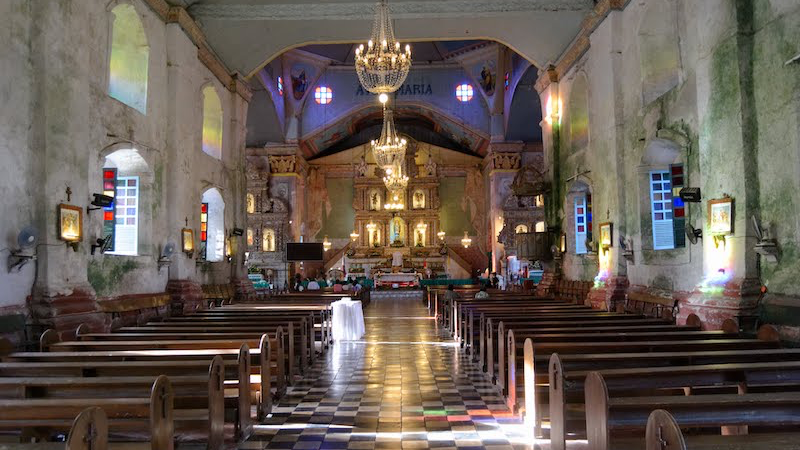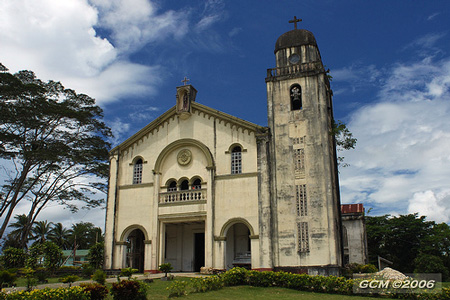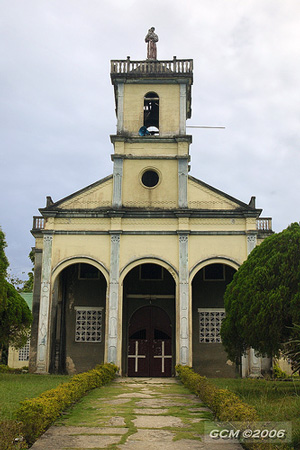⭐ BEST FERRY via CEBU & Countryside Tour: Our pick for Ferry Tickets and Countryside Tours.
- Bohol
- Bohol Attractions
- Bohol Spanish Churches
Bohol Churches: Legacy of Faith Discovering the Spanish Colonial Heritage
Welcome to Bohol, a province steeped in history and cultural heritage. In this captivating travel guide, we embark on a journey through time to explore the Spanish colonial churches that dot the landscape. From their architectural splendor to their religious significance, join us as we uncover the rich legacy of faith left by the Spanish colonizers in Bohol.
Ready to explore the beautiful islands of Cebu and Bohol? Secure your ferry tickets today through 12go and start your unforgettable journey!
Bohol's Spanish colonial churches serve as tangible reminders of the region's colonial past. Built during the Spanish era, these architectural marvels stand as witnesses to centuries of history, reflecting the cultural fusion of Spanish and local influences. Visiting these churches provides a glimpse into the island's colonial heritage and the enduring power of faith.
The Church of Our Lady of the Immaculate Conception or Baclayon Church
Baclayon Church (La Purisima Concepcion de la Virgen Maria): The Baclayon Church, officially known as the Church of La Purisima Concepcion de la Virgen Maria, stands as a testament to the rich history and architectural brilliance of Bohol. This church, considered a National Cultural Treasure, holds the distinction of being one of the oldest stone churches in the Philippines, dating back to 1727. Its grand façade showcases intricate carvings and reliefs, while the interior is a masterpiece of Philippine Baroque design. The retablo mayor, an elaborately decorated altarpiece, is a notable feature, boasting intricate woodwork and religious statues. Baclayon Church is a significant pilgrimage site and a fascinating cultural landmark that offers a glimpse into the region's colonial past.
The Dauis Church: Our Lady of the Assumption Parish Church
Dauis Church (Assumption of Our Lady): The Dauis Church, officially known as the Church of the Assumption of Our Lady, is a captivating historical landmark. It is recognized as a National Cultural Treasure and National Historical Landmark due to its rich cultural and architectural heritage. The church, which dates back to 1863, displays an impressive façade characterized by a combination of Gothic and Moorish architectural influences. The interior of the church is equally remarkable, featuring a Renaissance artesonado or coffered ceiling that creates an illusion of depth and grandeur. Visitors can also appreciate the beautiful paintings attributed to renowned artists Ray Francia and Canuto Avila. Notably, a small well on the floor in front of the main altar serves as a unique feature of the church.
St Peter Parish Church, Loboc
Loboc Church: The Loboc Church, located in the town of Loboc, is an architectural gem that showcases the artistic prowess of local craftsmen. The church is adorned with ceiling murals attributed to Canuto Avila, Ricardo Avila, and Rey Francia, adding a touch of beauty and grandeur to the interior. These murals depict religious scenes and serve as a testament to the rich artistic tradition of the region.
The church's façade exudes a simple yet elegant charm, with its stone walls and decorative details. It stands as a place of worship and a symbol of the community's deep-rooted faith. The Loboc Church is a cherished heritage site that invites visitors to appreciate the cultural heritage and artistic achievements of the local community.
Loboc Church: The Loboc Church, located in the town of Loboc, is an architectural gem that showcases the artistic prowess of local craftsmen. The church is adorned with ceiling murals attributed to Canuto Avila, Ricardo Avila, and Rey Francia, adding a touch of beauty and grandeur to the interior. These murals depict religious scenes and serve as a testament to the rich artistic tradition of the region.
The Loay Church: San Pedro Apostol (St. Peter the Apostle)
Loay Church (La Santisima Trinidad): Perched atop a hill overlooking the town of Loay, the Loay Church, officially known as the Church of La Santisima Trinidad, is a National Historical Landmark that holds great historical and architectural significance. The church dates back to 1822 and features a commanding presence with its solid stone façade and a majestic bell tower. The church complex also includes a bell tower, a convento, and two schoolhouses, which further showcase the historical importance of the site.
Loay Church is cruciform, has two facades: the older is decorated with low relief and the newer was apparently completed in the 20th century as its upper register is in reinforced concrete. The bell tower is a separate structure built at a short distance from the church. Like many Bohol churches the interior is painted with trompe o'eil and with Biblical scenes - in the Neoclassical style.
The interior of the Loay Church is a sight to behold, with its exquisite lace-like design adorning the sanctuary. The delicate patterns create a sense of intricacy and elegance that sets it apart from other churches. Ceiling murals attributed to Ray Francia further enhance the beauty of the interior, depicting religious scenes and adding a touch of artistry to the space. The church's location atop a hill offers breathtaking panoramic views of the surrounding countryside, making it an ideal spot for quiet contemplation and reflection.
Adjacent to the church is the old tribunal or municipal hall, a historic structure that adds to the cultural significance of the site. Together, the Loay Church and its surrounding buildings provide visitors with a glimpse into the region's past, as well as a deeper understanding of the religious and cultural heritage of Bohol.
The Dimiao Church: St. Nicholas of Tolentino Church
Our journey continues to the town of Dimiao, where the St. Nicholas of Tolentino Church awaits. This impressive structure, with its distinct octagonal bell tower, showcases a unique architectural style. Step inside to discover the ornate retablos and religious artworks that adorn the church. The Dimiao Church stands as a testament to the faith and craftsmanship of its builders.
Dimiao Church (San Nicolas de Tolentino): The Dimiao Church, officially known as the Church of San Nicolas de Tolentino, stands as a National Cultural Treasure, showcasing remarkable architectural and artistic craftsmanship. Constructed between 1800 and 1815, the church displays a combination of Baroque and Neoclassical elements in its design.
The exterior of the Dimiao Church is characterized by its solid stone walls and intricate details, including carvings and reliefs. It exudes a sense of grandeur and timelessness. Inside, visitors are greeted by a serene and prayerful atmosphere. The interior of the church features beautiful religious artwork and decorations. The altar and retablo showcase intricate woodwork and delicate sculptures, portraying scenes from the life of San Nicolas de Tolentino.
Adjacent to the church is an old walled cemetery locally referred to as "ermita." This cemetery adds a touch of historical charm and provides insights into the burial customs and traditions of the past.
The Maribojoc Church: Our Lady of the Assumption Church
Maribojoc Church (La Santa Cruz): The Maribojoc Church, officially known as the Church of La Santa Cruz, is a National Cultural Treasure that stands as a testament to the rich heritage of Maribojoc town. The present church was constructed in 1852 and features a captivating blend of architectural styles.
Inside the Maribojoc Church, visitors will discover five magnificently carved Gothic retablos, adorned with Mudejar stars. These intricate and elaborate retablos are masterpieces of craftsmanship, showcasing the skill and dedication of the local artisans.
The church's interior is also adorned with ceiling murals painted by Rey Francia. These murals, depicting religious themes and scenes, contribute to the overall aesthetic beauty and spiritual ambiance of the church.
The Maribojoc Church's historical and artistic significance is further enhanced by the presence of the Punta Cruz Watchtower, a nearby fort known as Castillo de San Vicente. This fortification, designated as a National Cultural Treasure, provides a glimpse into the region's history and adds to the charm of the Maribojoc Church's surroundings.
Panglao Church (San Agustin):
Situated in the scenic town of Panglao, the Panglao Church, officially named the Church of San Agustin, is a National Cultural Treasure that showcases the rich cultural and religious heritage of the province. The church was constructed between 1894 and 1897 and boasts a distinct architectural style, blending Gothic and Neoclassical elements. Visitors will notice the ruins of the old church nearby, which add a touch of historical charm to the surroundings. Inside the church, intricate ceiling murals adorn the vaults, depicting religious scenes and motifs. The peaceful ambiance and cultural significance of the Panglao Church make it a must-visit destination for those exploring Bohol's heritage.
This church was ruined before in 1886, when it is reported that a provisional church of wood and tabique was constructed. To the rear of the ruins and at some distance, stands a five story bell tower/ watch tower built 1851. Octagonal in plan and covered by pitched roof, the tower is said to be the tallest of its kind in the country.

Duero Church is designed in the “Greek temple” revival style similar to a few churches (Anda, Dumaguete, and Malabon designed by Luciano Oliver in 1861 among them). But what sets Duero apart is the generous use of wood. Indeed, it is one of the few surviving “gems of Philippine architecture in wood” (Jose 2001, 50).
Duero Church (Immaculate Conception): The Duero Church, dedicated to the Immaculate Conception, is considered one of the architectural gems of the Philippines due to its unique construction. Unlike many other churches in the country, the Duero Church is made entirely of wood. Built in 1874, it showcases exquisite woodwork and craftsmanship.
The church's wooden architecture is a testament to the skill and creativity of the local craftsmen who built it. The intricate details, including carvings and decorative motifs, adorn the church's interior and exterior. The Duero Church stands as a remarkable example of how wood can be transformed into a stunning and enduring structure.
Inside the church, visitors will find splendid ceiling murals by Rey Francia. These murals, painted on tin sheets, depict religious scenes and contribute to the overall aesthetic beauty of the church. The Duero Church offers a unique and memorable experience for those interested in Philippine architectural heritage.
Anda Church faces the beach, separated from it by a wide-open field. The church is cruciform with a plain and austere facade enlivened by doors and windows. The interior however is a pleasant surprise with the colorful ceiling paintings by Ray Francia, the retablos the use Greco-Roman motifs, and the Art Deco confessionals. The adjoining convento was built in the 1880s and completed a decade later.
Anda Church (Sto. Niño): The Anda Church, dedicated to the Sto. Niño (Child Jesus), may appear unimpressive from the outside, but its interior reveals a rich display of artistry and craftsmanship. Inside the church, visitors are greeted by splendid ceiling murals by Rey Francia.
The ceiling murals, painted on tin sheets, showcase intricate details and vibrant colors, depicting religious motifs and scenes. These exquisite murals add a touch of grandeur and beauty to the interior of the church.
The Anda Church's interior decoration goes beyond the ceiling murals. Visitors will also find rich decorations and adornments throughout the church, including ornate altars, religious statues, and intricate woodwork. The attention to detail and the artistic expressions found within the church create a visually stunning and spiritually uplifting experience.
Despite its unassuming exterior, the Anda Church surprises and captivates with its rich interior decorations. It serves as a testament to the deep faith and artistic talent of the local community. The church offers a serene and contemplative atmosphere, inviting visitors to immerse themselves in the religious and cultural heritage of Bohol.

Cortes Church (Santisimo Nombre de Jesus): The Cortes Church, officially named the Church of Santisimo Nombre de Jesus, is a religious landmark that dates back to 1892. It boasts an impressive architectural design, characterized by its solid stone walls and a classic bell tower.
Inside the Cortes Church, visitors are treated to a visual feast of artistry. The painted ceilings, attributed to renowned artist Rey Francia, are a sight to behold. These ceiling murals showcase intricate details and vibrant colors, depicting religious scenes and motifs that inspire a sense of awe and reverence.
The church's interior ambiance, with its serene atmosphere and beautiful decorations, provides a serene space for prayer and reflection. The Cortes Church is not only a place of worship but also a testament to the cultural and artistic heritage of Bohol.

Loon Church (Nuestra Senora de la Luz): The Loon Church, dedicated to Nuestra Senora de la Luz (Our Lady of Light), is one of the grandest churches in the Visayas region. It holds the distinction of being a National Cultural Treasure and National Historical Landmark, exemplifying the rich cultural and architectural heritage of Bohol.
The Loon Church was constructed between 1855 and 1864 and showcases a unique blend of architectural styles, combining elements of Gothic, Moorish, and Neoclassical influences. Its grand façade, characterized by towering buttresses and intricate details, commands attention and evokes a sense of awe.
Loon Church central facade surges forward giving it a dynamism more akin to Baroque than the Neoclassical style prevalent during this period. Delicately though inaccurately carved acanthus decorate the capitals of the twined columns of the facade. Between the twined columns are plaques incised with Biblical texts and dedicatory phrases.
Inside the Loon Church, visitors will find a wealth of artistic treasures. The church's interior features ornate altars, delicate sculptures, and magnificent stained glass windows, all contributing to its grandeur. The ceiling murals, painted by renowned artists Rey Francia and his contemporaries, add a touch of vibrancy and beauty to the space.
The Loon Church stands as a significant historical and cultural landmark, preserving the architectural splendor and artistic heritage of Bohol. Its grandeur and elegance make it a must-visit destination for those interested in Philippine history, art, and culture.

Jagna Church (San Miguel Arcangel):
The Jagna Church, dedicated to San Miguel Arcangel (St. Michael the Archangel), showcases a fascinating blend of architectural styles. While the church's facade has undergone significant renovations, the interior retains its original design and remains intact.
The highlight of the Jagna Church is its ceiling, adorned with beautiful paintings attributed to Rey Francia. These captivating artworks depict religious scenes and add a touch of color and vibrancy to the church's interior. The intricate details and vibrant colors of the ceiling paintings make them a remarkable sight to behold.
The Jagna Church serves as a place of worship and an important spiritual center for the local community. Its historical and artistic significance makes it a noteworthy stop for those exploring the churches of Bohol.

The Valencia Church is cruciform with a steep roof and a pyramidal crossing tower. Cut stone is used in parts of the church like the facade, however, concrete is found elsewhere. The real treasure of the church is its wooden floor of alternating dark (tindalo or balayong) and light (molave or tugas) wood planks.
Valencia Church (Sto. Niño): The Valencia Church, dedicated to the Santo Niño (Child Jesus), may not have an elaborate facade, but its interior reveals hidden artistic treasures. As visitors step inside, they are greeted by ornate wooden floor patterns that add a unique and captivating touch to the church's interior design. These patterns showcase the meticulous craftsmanship and attention to detail of the local artisans.
While the church's exterior may be modest, the intricate wooden flooring inside creates a sense of reverence and awe. It is a testament to the creativity and skill of the local craftsmen who dedicated their efforts to create such an impressive work of art.
Bohol Churches: Cultural and Historical Significance
The churches of Bohol, spread across the different routes, offer a fascinating journey through time and artistry. Each church tells a unique story, showcasing the architectural styles, artistic traditions, and religious devotion of the communities that built them.
Visiting these churches provides an enriching experience, allowing travelers to appreciate the rich cultural heritage of Bohol. From the intricate woodwork and ceiling murals to the grand facades and historical significance, these churches serve as windows into the past, offering glimpses of the vibrant and diverse history of the province.
As visitors explore the churches, they can also immerse themselves in the spiritual atmosphere, finding solace and tranquility in these sacred spaces. Whether it's admiring the intricate details of the altars, marveling at the vibrant ceiling murals, or simply taking a moment for quiet contemplation, the churches of Bohol offer a chance for personal reflection and connection.
Beyond their religious and artistic value, these churches serve as symbols of resilience and perseverance, having withstood the test of time, natural calamities, and historical challenges. They stand as proud reminders of the faith and cultural heritage of the communities that have called Bohol home for generations.
Cultural Immersion and Community Engagement:
To truly experience the spirit of Bohol, engage with the local communities surrounding the Spanish colonial churches. Visit the bustling markets, try traditional delicacies, and strike up conversations with the friendly locals. Immerse yourself in the island's rich cultural heritage by participating in cultural workshops, attending traditional music and dance performances, or even volunteering for community-based projects.
History of Catholic Bohol Churches
The first missionaries in Bohol were the Jesuits. When the Jesuits were expelled from the Philippines in 1768, the Augustinians and the Recollects took over. The Jesuits established parishes as early as 1595. Among the oldest parishes in Bohol are those in the towns of
Other churches of 18th and 19th century vintage worth a tourist’s visit are those in the towns of
|
|
Churches are significant depositories of art, especially of painting, sculpture and music. They are living museums, rich in artifacts that are mementos of a faith that has blossomed through the ages.
Spain’s main mission in sending expeditions to the East was to spread Christianity. As each Spanish explorer discovered land and claimed it for Spain, they immediately established missions to strengthen their claim.
Early records show that the Bohol mission started from a request made to the Jesuits by a certain Dona Catalina de Bolanos, who acted in behalf of her encumendero son, Pedro de Gamboa. It was the role of encumenderos to Christianize the places they occupied. In the 16th century, Bohol had an estimated populace of 10,000.
In November of 1596, two Spanish Jesuit priests arrived in Bohol to start a mission. They first established one in Baclayon. Later, they moved inland to Loboc, a market village, where 11 barangays were grouped to form the town. While the Spanish Residencia Boolana was in Baclayon, the mission head preferred to live in the inland town of Loboc
The early missionaries met setbacks in Bohol. In 1621-1622, while the Jesuits were celebrating in Cebu the beatification of St. Ignatius de Loyola and St. Francis Xavier, the Diwata Rebellion erupted.. All the towns in Bohol, except Baclayon and Dauis, defected. Armed troops were sent to quell the revolt. Forced labor were imposed upon the rebels which resulted in the construction of the massive, centuries-old churches we now have today.
In the late 1700’s, the Residencia Boolana was moved to Dauis, in the island of Panglao. Panglao Island, which is composed of two towns – Dauis and Panglao , is separated from the mainland of Bohol by a narrow, shallow channel.
Today, the island is connected to the mainland by two causeways and has become the major point of tourist destination with its multifarious attractions.
Since Spanish times, the Church in Bohol was a part of the Diocese of Cebu. It was only on November 9, 1941 that Bohol became a bishopric, with Msgr. Julio Rosales installed as its first bishop. Msgr. Rosales eventually became Archbishop of the Archdiocese of Cebu and a Cardinal of the Holy See in Rome.
Database of Bohol Churches, both Spanish and Modern

Alburquerque Church (Santa Monica): The Alburquerque Church, dedicated to Santa Monica, is a charming religious structure that dates back to 1885. While it may not be as well-known as some of the larger churches in Bohol, it exudes a sense of quiet beauty and simplicity. The church features a modest yet elegant design, characterized by its sturdy stone walls and a traditional bell tower. Inside, visitors will find a serene atmosphere conducive to prayer and contemplation. The Alburquerque Church stands as a reminder of the strong Catholic heritage and the faith of the local community.
 |
Antequera Church The Nuestra Señora del Rosario parish of Antequera was founded in 1880. The church by this date was of tabique pampango and other light material. |
 |
Balilihan church of poured concrete has a nave divided into three aisles, a portico in front of the facade and a bell tower in front of the portico. The cruciform church dedicated to Nuestra Señora del Carmen has a squat octagonal cupola. The interior is embellished with paintings by Ray Francia, and has altars that combine Corinthian columns, neogothic spires and crockets, Baroque volutes and Art Deco open work. A veritable summary of 200 years of style. |

Calaca Church
 |
Calape Church is a good example how colonial styles persisted even if the Spaniards who promoted them had already left. All of the structure is basically a lintel and post type, gothic features like lancet arches, rose window, spires and crockets are merely decorative. |
 |
Candijay Church Candijay is a 4th class municipality in the province of Bohol, Philippines. According to the 2000 census, it has a population of 30,389 people in 5,420 households. |
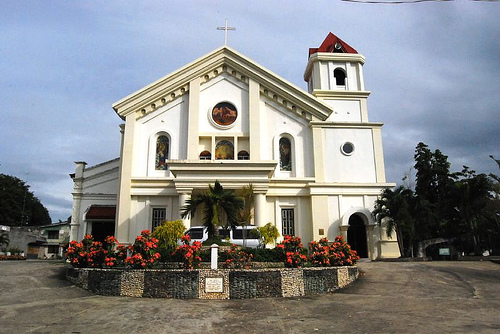 |
Clarin Church continues the neogothic style prevalent in Bohol with a central tower in front of the facade, which serves both a bell tower and portico. Lancet windows, finials, and other Gothic motifs are expressed in cement. |
 |
Corella Church The people of Corella are predominantly conservative Roman Catholics who belong to the Parish of Our Lady of the Village (Latin: Nuestra Señora del Villar) whose feast is celebrated on April 27, only four days before the Feast of St. Joseph, the patron saint of Tagbilaran City celebrated on May 1. |

A heritage site, the present Garcia Hernandez Church was commenced in 1880 and completed in 1896, replacing an earlier church. However, an earthquake in 1990 damaged the facade. The rebuilt facade is in a completely new style unsympathetic to the older church. The interior has a main nave flanked by side aisles. A Doric frieze runs across the church. The device of the frieze and fluted columns are used in the retablo mayor.
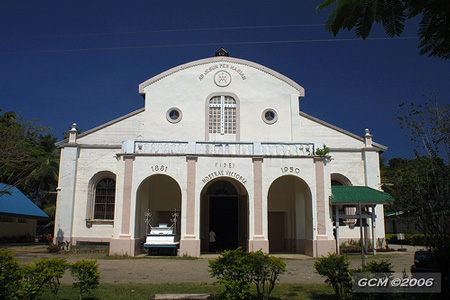 |
The present Guindulman Church is of mixed material, the lower register of coral stone and the upper of concrete, reflecting the long time it took to complete it. A portico was built in front of the facade and supports a balcony. The church interior is relatively bare, with ornaments from the 1950s and 60s. |

Inabanga Church is composed of various materials, the last being concrete, introduced by the secular priest Fr. Quiterio Sarigumba in 1931. The church uses gothic elements in the facade and has a portico in front of the entrance. The interior is modern, except for an exquisite wooden tabernacle probably from Jesuit times and the murals of the Garces brothers, done in the style of Canuto Avila and Ray Francia.
 |
The Jetafe Church facade resembles that of Tubigon, where a central tower houses the bells on the upper story and the lower story forms a portico before the main entrance. It resembles early Florentine Renaissance churches. The church follows the basilica plan with a central nave flanked by aisles. |
 |
Typical of Bohol churches Lila Church has a portico, which is flanked by bell towers. The interior is divided by a colonnade into a central nave with flanking aisles. The altars, inspired by neoclassic lines, and the ceiling paintings demonstrate the persistence of the colonial idiom into the 20th century. |

Maribojoc Church is planned as cruciform. Its facade is plain, decorated by thin pilasters and niches with images of saints. The interior comes as a surprise because of the three Neogothic altars in the church. The traceries and finials of gilded hardwood are delicately carved. The main altar has an image of the Blessed Trinity and bas relieves of the life of Mary Magdalene. The church ceiling is made of metal and painted with catechetical and liturgical motifs



Tagbilaran Cathedral (St. Joseph the Worker): The Tagbilaran Cathedral, also known as St. Joseph the Worker, is the main cathedral of the Diocese of Tagbilaran. It holds great significance as the seat of the bishop and the center of religious activities in the area. The cathedral features a beautiful architectural design, with its façade adorned with intricate details and a towering bell tower. Inside, visitors can admire the elegant interior, ornate altars, and stained glass windows that depict biblical scenes. The cathedral serves as a spiritual sanctuary for the Catholic community in Tagbilaran, offering a serene and tranquil atmosphere for prayer and reflection.
Among the many points of interest Tagbilaran city offers are three churches of the Catholic faith that deserves a prayerful tourist’s visit. These are the centuries-old Cathedral of Saint Joseph the Worker, the Knights of Columbus Parish Church of Our Lady of Lourdes, and the Shrine of the Birhen sa Barangay of the Cogon Parish.

The Talibon Cathedral of Talibon as built hews closely to the Escondrillas’ plan. However, the architect’s sedate plan for the facade’s was overtaken by a virtuoso display of the stone carvers art. Columns are sheathed in garlands of leaves. The facade’s rich ornamentation is unfortunately not carried into the plain interior.Talibon with the advocacy of the Most Holy Trinity is the cathedral of the diocese of Talibon, erected in 9 January 1986.

The Tubigon Church follows the basilical plan of a central nave with aisles, however, it has a transept, and crossing is covered by an octagonal cupola. The church fabric shows a mixture of materials, the upper part of the wall and most of the facade is concrete, however, the lower part is of rubble bound by lime mortar.
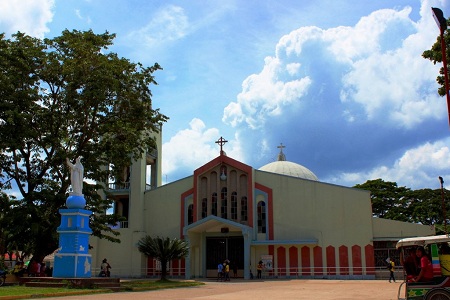
Although Redondo (1886, 182) describes the Ubay Church as provisional and made of wood, it was rebuilt soon after by Fray Buenaventura Marrodan (1891-97). The present church is of new construction. While parts of the apse, narthex and entrances to the transept belong to a 1920’s church, the rest were rebuilt when a typhoon damaged the church in 1968.

The churches along the various routes in Bohol offer a captivating journey through the province's history, art, and culture. Each church holds unique architectural features, historical significance, and artistic treasures that make them invaluable cultural landmarks. Exploring these churches provides a deeper understanding of Bohol's rich heritage and offers a glimpse into the artistic and religious traditions that have shaped the province's identity.
Top Bohol Attraction guides
- Best Bohol Tour Packages for 2023: Unforgetable Trips
- Bohol Island Tours: Discovering the Natural Charm by Locals
- Best of Bohol Attractions: Natural, Cultural, Heritage + More
- What to Do in Bohol: Your Ultimate Guide to Unforgettable Experiences
- Natural Wonders of the World All in Bohol
- Bohol Geopark xploring the Geological Marvels
- Bohol Baroque Churches: A Glorious Testament to Filipino Faith
- Bohol Heritage and Architectural: Guide to Top Historical Structures
- Bohol Historical Sites
- Bohol Adventure: The Ultimate Guide to Outdoor Sports Activities
- Best of Bohol White Sand Beaches for Your Next Island Getaway
- Bohol Island Hopping: Best Experience Tours
- Whale and Dolphin Watching A Comprehensive Guide
- Bohol Diving: Discover the World Famous Underwater Paradise
- Stand-up Paddle Boarding Bohol: the Fastest Growing Sport
- Bohol Adventure and Eco Parks
- Things to Do in Bohol | Best things to do Bohol
- Panglao Island | 45 Things to Do in Panglao
Ready to explore the beautiful islands of Cebu and Bohol? Secure your ferry tickets today through 12go and start your unforgettable journey!
recommended hotel booking
Book your stay in Bohol's breathtaking surroundings through Agoda and experience the ultimate relaxation
Top 25 Sights and Attractions in Bohol
- Chocolate Hills
- Tarsier Conservation Sanctuary
- Panglao Island
- Loboc River Cruise
- Hinagdanan Cave
- Balicasag Island
- Alona Beach
- Bilar Man-made Forest
- Blood Compact Shrine
- Baclayon Church
- Bohol Bee Farm
- Anda Beach
- Sipatan Twin Hanging Bridge Loboc
- Danao Adventure Park
- Sagbayan Peak
- Butterfly Conservation Center
- Clarin Ancestral House
- Dimiao Twin Falls
- Mag-Aso Falls
- Anda White Beach
- Lamanok Island
- Rajah Sikatuna Protected Landscape
- Dauis Church
- Can-umantad Falls
- Punta Cruz Watchtower
All Rights Reserved ©2024. Bohol Philippines Travel Guide
Address: Talibon, Bohol, Philippines

